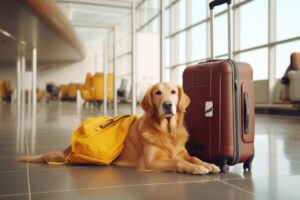Moving house is one of the most stressful experiences anyone can endure. From sorting through belongings and packing essentials to coordinating with utility companies and meeting tight deadlines, the process can feel overwhelming.
Amidst all this chaos, it’s easy to overlook the well-being of your pet, who can pick up on the changing routine and your rising stress levels. To help you and your pet navigate this challenging time, we’ve compiled a series of tips for traveling with pets and ensuring their comfort during a move.
The Science of Dog Stress
 Understanding why moving is stressful for dogs can help you better manage their anxiety. Dogs are highly perceptive and can sense changes in their environment and emotional state. Reading your dog’s body language can provide insights into their feelings. Signs of stress in dogs include a tense body, stiff tail, ears pulled back, and intense staring. How you respond to these signs depends on your relationship with your dog.
Understanding why moving is stressful for dogs can help you better manage their anxiety. Dogs are highly perceptive and can sense changes in their environment and emotional state. Reading your dog’s body language can provide insights into their feelings. Signs of stress in dogs include a tense body, stiff tail, ears pulled back, and intense staring. How you respond to these signs depends on your relationship with your dog.
For dogs that you’ve had since they were puppies, offering comfort and cuddles can help alleviate their anxiety. However, for shelter dogs or those with a history of trauma, it’s essential to be cautious and respectful of their space. Misinterpreting their stress signals could lead to unintended consequences, such as increased anxiety or defensive behavior.
It’s also important to dispel cultural myths about dog behavior. The idea that certain breeds are inherently aggressive is not supported by evidence; a dog’s behavior is shaped by their experiences and training.
Flying with Your Pet
Traveling by plane with your pet can be daunting, especially with the thought of your furry friend traveling in the cargo hold. Many airlines allow pets to travel with luggage, but this can be worrying for pet owners. Fortunately, most airlines will check on your pet during the flight, particularly for longer journeys. If the airline staff doesn’t offer this service, simply inform them about your pet, and they will typically accommodate your request.
Before flying, research and prepare thoroughly. Know the type of cage required for your pet, the specific airline and airport regulations, and any vaccination requirements. The complexity of flying with a pet can vary significantly; moving a large breed like a Doberman from one country to another is vastly different from flying with a kitten to a neighboring state.
For domestic moves within the United States, the process generally involves acquiring a suitable cage, getting your pet accustomed to it, and ensuring all necessary documentation is in order. Your veterinarian can provide guidance on any additional health checks or requirements needed for the journey.
The Cage: An Essential Preparation
If flying is part of your moving plan, investing in a cage well in advance is crucial. Pets often resist entering a cage if they are not accustomed to it, adding unnecessary stress to the move. Order and purchase the cage at least a month before your travel date to allow ample time for acclimatization.
Introduce the cage to your pet gradually. Leave it open in a familiar space and let your pet explore it at their own pace. Patience is key, as it may take days or even weeks for your pet to feel comfortable inside. Use treats and positive reinforcement to encourage your pet to enter the cage. This training process should be consistent and gentle, helping your pet associate the cage with positive experiences rather than fear.
Settling into Your New Home
 Once you’ve arrived at your new home, the hardest part is over. Now it’s time to help your pet settle in. Dogs are generally loyal and adaptable, and they will likely be excited to explore their new environment with you. However, some dogs may exhibit territorial behavior, such as marking their new space by urinating. This behavior is normal and should subside as your dog becomes familiar with their new surroundings.
Once you’ve arrived at your new home, the hardest part is over. Now it’s time to help your pet settle in. Dogs are generally loyal and adaptable, and they will likely be excited to explore their new environment with you. However, some dogs may exhibit territorial behavior, such as marking their new space by urinating. This behavior is normal and should subside as your dog becomes familiar with their new surroundings.
To ease the transition, maintain a consistent routine. Keep feeding, walking, and playtime schedules the same as before the move. Provide familiar items, such as your pet’s favorite toys and bedding, to create a sense of continuity and comfort.
Pet-Friendly Northern Virginia
If you’re relocating to Northern Virginia, you’ll find it a welcoming place for pet owners. Many communities in this region offer pet-friendly housing options and amenities. If you’re still in the planning stages of your move, research the best pet-friendly neighborhoods in Northern Virginia to ensure a smooth transition for you and your pet. Avoid the added stress of dealing with a landlord who has unrealistic rules about pets by choosing a pet-friendly home from the start.
Reach Out Northern Virginia’s Top Pet Sitters
Moving can be a stressful time, but with careful planning and consideration, you can make the process smoother for both you and your pet. Understanding your pet’s stress signals, preparing for travel, and ensuring a comfortable transition to your new home are key steps in minimizing anxiety and ensuring a positive experience. By following these tips, you can help your pet adapt to their new environment and maintain their well-being throughout the move.
For the best support during your move, trust the experts at Paw Pals Pet Sitting. Reach out to Northern Virginia’s top pet sitters today and ensure your furry friend receives the care and attention they deserve during this transitional period. Contact us now to learn more about our services and how we can help make your move easier for you and your pet!


